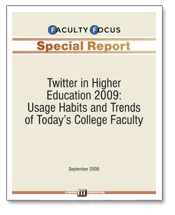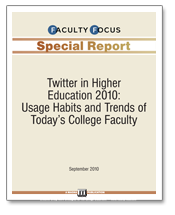
Senior Instructor, Department of Computer & Information Science (DCIS)

|
Vat Kam Hou 屈鑑濠 Senior Instructor, Department of Computer & Information Science (DCIS) |
Social Media Usage Trends Among Higher Education Faculty
|
The popularity of social media and its rapid ascension into our daily lives is nothing short of astounding. Sites that weren’t even around 10 years ago are now visited every day. What’s more, 56 percent of the faculty surveyed said they expect their use of social media to increase this school year.Do you friend your students on Facebook? Do you tweet, or use Twitter in the classroom? Do you network on LinkedIn, and participate in its groups? Does your college or university have a social media policy? For the past two years, Faculty Focus conducted a survey on Twitter usage in higher education. This year we expanded the survey to include Facebook and LinkedIn, while adding a number of new questions as well. Twitter, Facebook and LinkedIn all have their strengths and weaknesses, and each are better used for some things than others. But how are the three being used in higher education today? It’s our hope that these survey results provide at least some of the answers while lending new data to the discussion. Here are just some of the findings from Social Media Usage Trends Among Higher Education Faculty, a 2011 Faculty Focus survey of nearly 900 higher education professionals:
|
Social Media Usage Trends Among Higher Education Faculty includes a complete breakdown of all the questions asked in the survey, as well as narrative comments. In many cases, the comments show a great divide between those who have embraced social media, and those who have not.
Here are just some of the comments, in their own words: I am quite sure that students are learning less and less because they are distracted by Facebook (primarily) when they should be engaged in the class. A concern that I have is that some students use social media inappropriately with faculty…e.g. too friendly and exposing personal matters… I’m a senior faculty member and it took me time to get over my resistance…now, I wouldn’t be without these tools for professional and personal use. Ever since we adopted the use of social media we’ve had better communication with students and the community. We also use it as an assessment and planning tool. We are using Twitter for an entire program. I hope that more instructors learn the value/opportunity in using these tools for learning – especially when instructors often use these tools for their own learning. It is very risky for a professional educator to use social media as a learning tool.
|
Synchronous and Asynchronous Learning Tools: 15 Strategies for Engaging Online Students Using Real-time Chat, Threaded Discussions and Blogs |
In a face-to-face class, students have numerous opportunities to interact with their instructor and fellow students. Creating similar opportunities for collaboration in a web-based course is one of the biggest challenges of teaching online. Yet, opportunities for meaningful synchronous and asynchronous interaction are plentiful, provided you design and facilitate your online course in the correct manner and with the proper tools.This free special report, Synchronous and Asynchronous Learning Tools: 15 Strategies for Engaging Online Students Using Real-time Chat, Threaded Discussions and Blogs, will provide you with practical advice from educators who’ve found effective ways to promote learning and build a sense of community in their online courses.Asynchronous and synchronous learning tools, such as threaded discussions, instant messaging and blogs, play an important role in humanizing online courses by replicating the classroom experience of information exchange and community building, not just between students and teacher but among the students as well. Meaningful online discussions that promote learning and prevent feelings of isolation do not happen spontaneously. They require thoughtful planning, good use of questioning techniques, and relevant incentives for student participation. |
This Faculty Focus special report features 15 articles from Online Classroom newsletter, and will provide you with specific strategies on how to use synchronous and asynchronous learning tools to engage your online students. Here are just some of the articles you will find in Synchronous and Asynchronous Learning Tools: 15 Strategies for Engaging Online Students Using Real-time Chat, Threaded Discussions and Blogs:
Discussion and interaction are the heart and soul of any online class, and, as such, require careful planning to make the interaction truly meaningful. Things to consider include how to encourage timely participation, how to grade contributions, how to use discussions to promote deeper thinking and understanding, and how to create a safe learning environment. Synchronous and Asynchronous Learning Tools: 15 Strategies for Engaging Online Students Using Real-time Chat, Threaded Discussions and Blogs will show you what works, and what doesn’t. |
Teaching with Technology: Tools and Strategies to Improve Student Learning |
If you’re interested in using technology tools to enhance your teaching, it’s easy to get overwhelmed by the mountain of information out there. To make matters worse, much of what you find is either highly technical or simply not very practical for the college classroom.That’s why we created this special report. Teaching with Technology: Tools and Strategies to Improve Student Learning approaches teaching technologies from your perspective — discussing what works, what doesn’t, and how to implement the best ideas in the best ways. |
The 13 articles in the report were written by John Orlando, PhD, program director at Norwich University, as part of the popular Teaching with Technology column on Faculty Focus. You’ll find that the articles are loaded with practical information as well as links to valuable resources. Here are the articles featured in the report:
Whether the courses you teach are face-to-face, online, blended, or all of the above, this report explains effective ways to incorporate technology into your courses to create a rich learning experience for students, and a rewarding teaching experience for you. |
Twitter in Higher Education 2009: Usage Habits and Trends of Today’s College Faculty
|
It happened seemingly overnight, but suddenly the education community is all a-Twitter. Or is it? That’s what Faculty Focus set out to learn when it launched in July 2009 a survey on the role of Twitter in higher education. The survey asked college and university faculty about their familiarity and use of the micro-blogging service, if any, as well as whether they expect their Twitter use to increase or decrease in the future.In higher education, many of the first adopters were professionals involved in marketing, admissions and alumni relations. Today a growing number of professors use Twitter to connect with like-minded colleagues around the country (or world) as well as in the classroom to keep students engaged, communicate important deadlines, and encourage succinct dialogue. The Faculty Focus survey of nearly 2,000 higher education professionals found that almost a third (30.7 percent) of the 1,958 respondents who completed the survey are using Twitter in some capacity. More than half (56.4 percent) say they’ve never used Twitter. The remaining 12.9 percent of respondents say they tried it, but no longer use it. Interestingly, while the majority of faculty do not currently use Twitter, their reasons are varied. Many questioned its educational relevance and expressed concerns that it creates poor writing skills. For others the reasons seemed to boil down to the simple fact that they either don’t know how to use Twitter, or don’t have time to use it. |
Key findings of Twitter in Higher Education 2009: Usage Habits and Trends of Today’s College Faculty include:
Depending how they answered the question — “Do you use Twitter?” — respondents were asked a unique set of follow-up questions. The 20-page report provides breakdown of the survey results by question, including comments provided by survey respondents. The comments allowed faculty to further explain how they are using Twitter, why they stopped, or why they have no interest in using it at all. It is clear that those educators who’ve had a good experience with Twitter are eager to share comments or anecdotes with others, as well as stretch their imagination to find new applications for using the tool to engage students inside and outside of the classroom. Here are just a few comments from faculty on how they use Twitter effectively: Currently, we have a Russian instructor using it to tweet on every day activities. His students respond in Russian. It gives him a chance to correct mistakes and it gives the students daily practice in writing and understanding the language. Students from other universities have joined in to make it a very dynamic learning tool. Turned a traditional assignment into a Twitter assignment. Received more quality and quantity of student input using Twitter. I use Twitter to encourage students to participate in class. It can be a good tool as long as the professor uses some structure in the discussion – such as posting questions about a reading for the students to answer. Of the survey participants who answered the question “What are your reasons for NOT using Twitter?” more than 161 added comments to further explain their position. Typically, the comments fell into the following categories:
Here are a few of the comments from educators who don’t use Twitter: My students don’t need another reason to distract themselves The only role Twitter would have in education would be to further dumb down the curriculum and the student body. It seems like another Web 2.0 technology that people are adopting simply because of its buzz factor and not a true ability to support teaching and learning. |
Twitter in Higher Education 2010: Usage Habits and Trends of Today’s College Faculty
|
s Twitter a powerful learning tool or a colossal waste of time? It depends whom you ask. In its second annual survey on the popular micro-blogging technology, Faculty Focus found a great divide in how professors perceive Twitter, including whether it should be used in the classroom or is best reserved for networking with peers.The 2010 Faculty Focus survey of nearly 1,400 higher education professionals found that more than a third (35.2 percent) of the 1,372 respondents who completed the survey in July-August 2010 use Twitter in some capacity. That’s up from 30.7 percent in 2009. Meanwhile, the percentage of people who never used Twitter decreased from 56.4 percent in 2009 to 47.9 percent in 2010. The remaining 16.9 percentage consists of those who tried Twitter, but stopped using —up from 12.9 percent in 2009. Of those who currently use Twitter, the most common activities include “to share information with peers” and “as a real-time news source.” Instructional uses, such as “to communicate with students” and “as a learning tool in the classroom” are less popular, although both activities saw increases over the previous year. Non-users expressed concerns that Twitter creates poor writing skills and could be yet another classroom distraction. Many also noted that very few of their students use Twitter. Finally, a new trend that emerged this year centered on the belief that many feel they already have too many places to post messages or check for student questions/comments. As one professor put it, “I have no interest in adding yet another communication tool to my overloaded life.” In terms of future use, just over half (56.8 percent) of current Twitter users say they expect to increase their use during the coming academic year. Only 2.5 percent say their Twitter use will likely decrease, and 40.7 percent say it will stay about the same. As we learned from last year’s survey, people have very strong feelings when it comes to Twitter. Not much has changed in that regard. Some still see it as a platform for people to make mind numbing pronouncements on the minutia of everyday life, while others say they use Twitter to build a strong personal learning network (PLN), communicate with students, and stay current. |
Here are just a few comments from faculty on how they use Twitter effectively: Greatest learning tool since Socrates spoke… No I’m not kidding. The access to industry leaders and educators I have developed is second to none! I find Twitter can be a useful academic tool. It provides immediate access to a world of ideas regarding the implementation of technology into pre-service teacher education. I’ve found Twitter useful for increasing students’ time thinking about course related content through tweeting supplemental content links and for some very limited student interaction. I’m hoping to encourage more student input. Twitter has been the most effective, efficient, and cheapest professional development I have had in years. Twitter is a useful educational tool, administrators need to reward faculty that push their teaching forward using innovative methods, otherwise other faculty see no value in expending time and energy on yet another thing to do. I’m quite happy with Twitter and what its ability to facilitate dissemination of information to groups in real time, but getting students to adopt it has been the biggest drawback.Here are a few of the comments from educators who don’t use Twitter: Too superficial, too instantaneous, leaves no time or space for reflection My goal as an educator is to get students to think deeply and extend their attention spans. This tool is completely antithetical to both. It is a sign of what is wrong with education today. Don’t need any more distractions for students. Keep the classroom free from this nonsense. When I asked my students if they would like me to start using Twitter, they almost universally said ‘no’. Instead, they felt it would be more useful to use Facebook. I may be an old codger, but between land lines, cell phones, Skype, email, Blackboard, and Facebook, I have enough to keep me busy. We use Moodle on campus which allows us to communicate using forums, blogs, wikis, etc. I don’t think it is necessary to use every tool available just for the sake of using them. You need to ask yourself if using the tool is actually adding value to the work that you do. |
Go to: Dr. Vat's FST Homepage | Recommended Items (Page 0 | 1 | 2 | 3 | 4 | 6 | 7 | 8 | 9)
Kam Hou Vat, PhD
Faculty of Science and Technology
University of Macau
Av. Padre Tomás Pereira, Taipa,
Macau, China
Room: N327C
Telephone: (Office) (853) 8397-4379, (Mobile) (853) 66501747
Fax: (Office) (853) 28838314 or (Home) (853) 28832731
Email: fstkhv
Personal Homepage: http://www.fst.umac.mo/en/staff/fstkhv.html
Downloadable: CV | Short Profile
Visitor Counter: